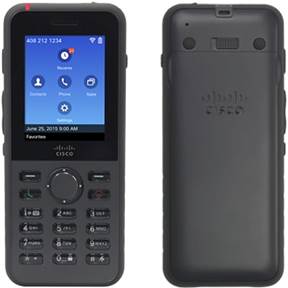
Cisco Unified IP Conference Phone 8821
Delivers cost-effective, on-premises, comprehensive voice over wireless LAN (VoWLAN) communications

Our Price: Request a Quote
Click here for more options and pricing!
Please Note: All Prices are Inclusive of GST
Overview:
The 8821 is specifically designed for workers whose roles are in more rigorous, industrial settings. Examples of ideal use cases include nurses and doctors in healthcare, operations and engineering staff in manufacturing, customer service representatives in retail, service staff such as maids in hospitality, and workers on rigs in the oil and chemical industries.
While the 8821 is sleek and lightweight, the design is hardened for users. It is Ingress Protection standard (IP67) rated and is sealed for protection against dust, splash and water. The device is also MIL-STD-810G tested, with a dozen drops onto concrete from heights of up to 6 feet (1.8 m), to help ensure shock resistance and avoid breakage if dropped.
The 8821 enhances security and simplifies configuration management. Stronger encryption is supported for certificate management and policy enablement with the support of Secure Hash Algorithm 2 (SHA-2). Simple Certificate Enrollment Protocol (SCEP) eases IT administration by enabling automatic certificate management on the device.
End users will enjoy a larger, higher-resolution color display and a user experience that is common with Cisco IP Phone 8800 Series desk phones. In addition, roaming between access points within the campus will support more seamless voice communications with the 8821’s support of Fast Transition (802.11r). This protocol was specifically designed for mobile voice over IP (VoIP) communications devices within Wi-Fi networks. Bluetooth is supported for the user’s choice of third-party wireless headsets and adds freedom by untethering the user from the handset.
The 8821 supports Cisco and/or third-party XML applications such as push-to-talk.
Features
The Cisco Wireless IP Phone 8821 (Figure 1) is designed for users in rigorous workspaces as well as general office environments. It supports a wide range of features for enhanced voice communications, quality of service (QoS), and security. Some of the main benefits and highlights are listed here:
- IEEE 802.11a/b/g/n/ac radio for VoWLAN communications support
- The large 2.4-inch (6 cm) color (240 x 320 pixels) display makes viewing easy
- IP67 rated for protection against dust, splash, and water
- MIL-STD-810G standard for shock resistance
- The phone offers exceptional voice quality with high-definition (HD) voice
- A built-in full-duplex speakerphone offers high-quality hands-free communications
- The phone supports third-party Bluetooth 3.0 headsets and a 3.5-mm headphone jack for added freedom
- The Applications key provides direct access to XML applications such as push-to-talk and Lone Worker
- Battery life delivers a minimum of 13 hours of talk time
- Enhanced encryption support for SHA-1 and SHA-2 signatures
- Fast, secure roaming using 802.11r and Cisco Centralized Key Management roaming
- Automatic certificate renewal - SCEP support
Technical Specifications:
Table 1 provides a list of the phone’s features, Table 2 summarizes the wireless characteristics, Table 3 lists specifications, and Table 4 provides certification and compliance information.
Table 1.Features
| Item | Description |
|---|---|
| Features |
|
| Buttons |
|
| Codecs |
|
| LEDs |
|
| Protocol |
|
| Call control |
|
| Security features |
|
| Provisioning and management |
|
| Configuration options |
|
| Application framework |
|
| User localization | Arabic, Bulgarian, Catalan, Chinese (Hong Kong), Chinese (China), Chinese (Taiwan), Croatian, Czech, Danish, Dutch, English (United Kingdom), English (United States), Estonian, Finnish, French (Canada), French (France), German, Greek, Hebrew, Hungarian, Italian, Japanese, Korean, Latvian, Lithuanian, Norwegian, Polish, Portuguese (Brazil), Portuguese (Portugal), Romanian, Russian, Serbian, Slovak, Slovenian, Spanish (Spain), Spanish (Colombia), Swedish, Thai, and Turkish |
| Network localization | Argentina, Australia, Austria, Belgium, Brazil, Canada, China, Colombia, Cyprus, Czech Republic, Denmark, Egypt, Finland, France, Germany, Ghana, Greece, Hong Kong, Hungary, Iceland, India, Indonesia, Ireland, Israel, Italy, Japan, Jordan, Kenya, Korea Republic, Lebanon, Luxembourg, Malaysia, Mexico, Nepal, Netherlands, New Zealand, Nigeria, Norway, Pakistan, Panama, Peru, Philippines, Poland, Portugal, Russian Federation, Saudi Arabia, Singapore, Slovakia, Slovenia, South Africa, Spain, Sweden, Switzerland, Taiwan, Thailand, Turkey, United Kingdom, United States, Venezuela, and Zimbabwe |
Table 2.Wireless Characteristics
| Item | Specifications | |||
|---|---|---|---|---|
| Protocols |
|
|||
| Frequency bands and operating channels |
|
|||
| Nonoverlapping channels |
|
|||
| Operating modes |
|
|||
| Data rates |
|
|||
| 2.4-GHz receiver sensitivity | IEEE 802.11b:
|
IEEE 802.11g:
|
IEEE 802.11n HT20:
|
|
| 5-GHz receiver sensitivity | IEEE 802.11a:
|
IEEE 802.11n HT20:
|
IEEE 802.11n HT40:
|
|
IEEE 802.11ac VHT20:
|
IEEE 802.11ac VHT40:
|
IEEE 802.11ac VHT80:
|
||
| Transmitter output power | 2.4 GHz:
|
5 GHz:
|
||
| Antenna |
|
|||
| Access point support |
|
|||
| Wireless security | Authentication:
|
Encryption:
|
||
| Fast, secure roaming |
|
|||
| Signature types |
|
|||
| Bit key types |
|
|||
| QoS |
|
|||
Table 3.Specifications
| Item | Specifications |
|---|---|
| Display |
|
| Dimensions (HxWxD) |
|
| Weight |
|
| Battery |
|
| Input power |
|
| Operating temperature |
|
| Storage temperature |
|
| Relative humidity |
|
| Vibration |
|
| Thermal shock |
|
| Altitude |
|
| Endurance |
|
| Drop specs |
|
| Headset |
|
| Connector |
|
Table 4.Certification and Compliance
| Item | Specifications |
|---|---|
| Safety |
|
| Electromagnetic compatibility and electromagnetic interference (EMC/EMI) |
|
| Telecom |
|
| Radio |
|
| RF Exposure |
|
Documentation:
Download the Cisco Wireless IP Phone 8821 DataSheet (PDF).
Pricing Notes:
- All Prices are Inclusive of GST
- Pricing and product availability subject to change without notice.
Our Price: Request a Quote

